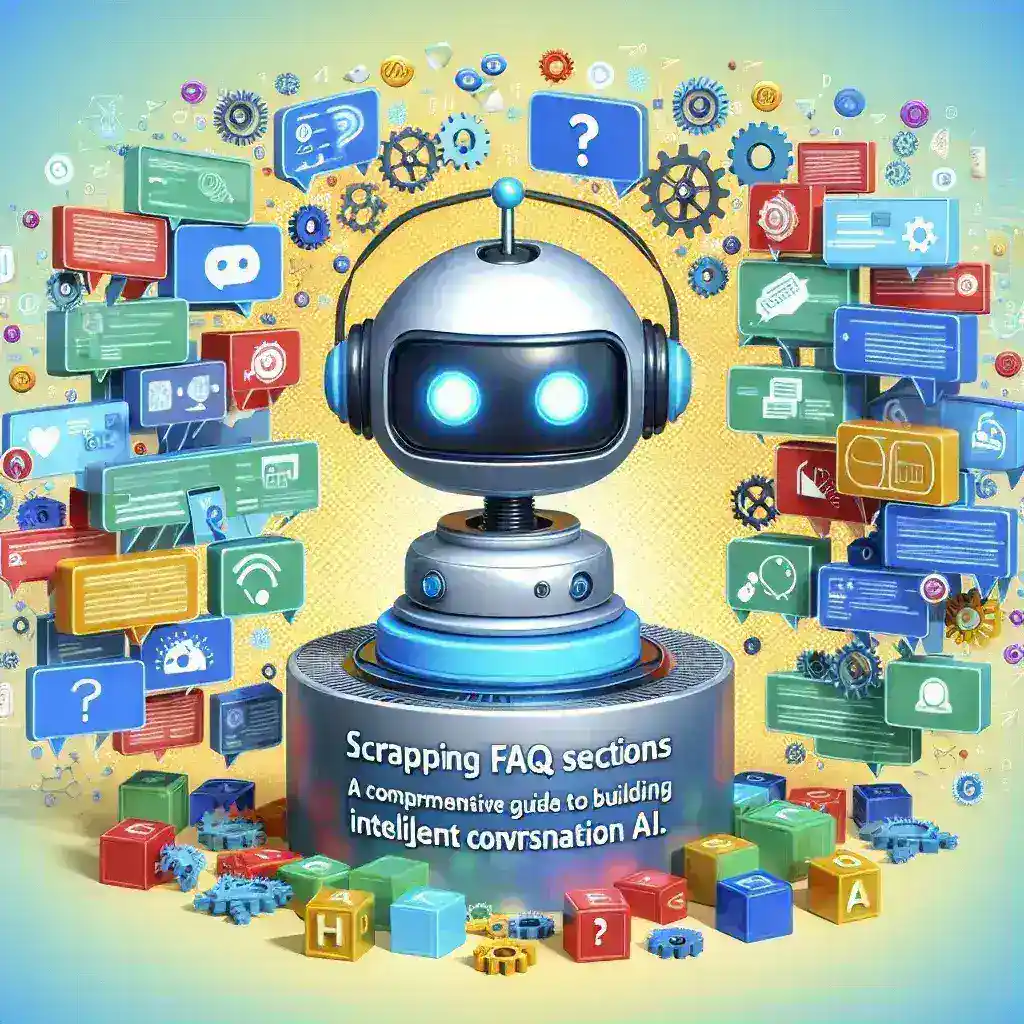In the rapidly evolving landscape of artificial intelligence and customer service automation, businesses are increasingly turning to chatbots to handle routine inquiries and provide instant support. One of the most effective methods for training these conversational AI systems involves scraping FAQ sections from websites to create comprehensive training datasets. This approach leverages existing knowledge bases to build more intelligent and responsive chatbots that can handle a wide variety of customer queries.
Understanding the Foundation of FAQ-Based Chatbot Training
FAQ sections represent a goldmine of structured question-and-answer pairs that have been carefully curated by businesses to address their customers’ most common concerns. These sections typically contain real-world problems and solutions that customers actually face, making them invaluable for training chatbots to respond appropriately to similar inquiries.
The process of scraping FAQ sections involves systematically extracting these question-answer pairs and transforming them into a format suitable for machine learning algorithms. This method offers several advantages over creating training data from scratch, including cost-effectiveness, authenticity, and comprehensive coverage of domain-specific topics.
The Strategic Importance of Quality Training Data
The effectiveness of any chatbot depends heavily on the quality and diversity of its training data. FAQ sections provide a unique advantage because they contain questions that customers have actually asked, phrased in natural language that real users employ. This authenticity ensures that the chatbot will be better prepared to understand and respond to genuine customer inquiries.
Moreover, FAQ sections often cover a broad spectrum of topics within a specific domain, from basic product information to complex troubleshooting scenarios. This comprehensive coverage allows chatbots to handle a wider range of conversations without requiring extensive manual data creation.
Technical Approaches to FAQ Section Scraping
Successfully scraping FAQ sections requires a combination of technical skills and strategic planning. The process typically involves several key steps, each requiring careful consideration of both technical and ethical factors.
Identifying Target Websites and Structure Analysis
The first step in any scraping project involves identifying websites with high-quality FAQ sections relevant to your chatbot’s intended domain. This might include competitor websites, industry leaders, or authoritative sources within your field. Once targets are identified, analyzing the HTML structure of these FAQ sections is crucial for developing effective scraping strategies.
Most FAQ sections follow common patterns, such as accordion-style layouts, tabbed interfaces, or simple question-answer lists. Understanding these patterns allows developers to create more robust scraping scripts that can adapt to various website structures.
Implementing Scraping Technologies
Modern web scraping for FAQ sections typically employs a combination of technologies. Python-based frameworks like Beautiful Soup, Scrapy, or Selenium are commonly used for their flexibility and powerful parsing capabilities. These tools can handle both static and dynamic content, ensuring comprehensive data extraction even from JavaScript-heavy websites.
For more complex scenarios involving single-page applications or heavily interactive FAQ sections, headless browsers like Puppeteer or Playwright may be necessary. These tools can simulate user interactions, clicking through expandable sections and navigating complex interfaces to access all available content.
Data Processing and Quality Assurance
Raw scraped data rarely comes in a format immediately suitable for chatbot training. Extensive processing is typically required to clean, structure, and validate the extracted information.
Cleaning and Standardization
FAQ content often contains HTML formatting, special characters, and inconsistent spacing that must be cleaned before use in training datasets. This process involves removing unnecessary markup, standardizing text formatting, and ensuring consistent encoding across all extracted content.
Additionally, many FAQ sections contain duplicate or near-duplicate questions phrased slightly differently. Identifying and handling these duplicates is crucial for preventing bias in the training data and ensuring the chatbot doesn’t develop overly specific responses to particular phrasings.
Quality Validation and Filtering
Not all scraped FAQ content will be suitable for chatbot training. Some questions may be too specific to particular companies, while others might be outdated or contain information that could be harmful if reproduced by a chatbot. Implementing quality filters helps ensure that only appropriate, high-quality content makes it into the final training dataset.
This validation process might involve checking for completeness of question-answer pairs, filtering out overly promotional content, and ensuring that answers provide genuine value rather than simply directing users to contact customer service.
Ethical Considerations and Best Practices
Scraping FAQ sections raises important ethical and legal considerations that must be carefully addressed to ensure responsible data collection practices.
Respecting Website Terms of Service
Before scraping any website, it’s essential to review and understand the site’s terms of service and robots.txt file. Many websites explicitly prohibit automated data collection, and violating these terms could result in legal consequences or technical countermeasures.
When scraping is permitted, implementing respectful practices such as rate limiting, using appropriate user agents, and avoiding excessive server load demonstrates good faith and helps maintain positive relationships with content providers.
Privacy and Data Protection
FAQ sections sometimes contain information that could be considered sensitive or personally identifiable. Ensuring compliance with data protection regulations like GDPR or CCPA requires careful review of scraped content and implementation of appropriate privacy safeguards.
This might involve anonymizing any personal information found in examples, removing references to specific individuals, and ensuring that the use of scraped data complies with applicable privacy laws and regulations.
Integration Strategies for Chatbot Training
Once FAQ data has been successfully scraped and processed, the next challenge involves effectively integrating this information into chatbot training pipelines.
Data Format Optimization
Different chatbot platforms and frameworks require training data in specific formats. Some systems work best with simple question-answer pairs, while others can leverage more complex structured data including context, intent labels, and entity annotations.
Transforming scraped FAQ content into these various formats requires understanding both the source data structure and the target training requirements. This might involve creating multiple versions of the same dataset optimized for different platforms or training approaches.
Combining Multiple Data Sources
FAQ scraping rarely provides sufficient data for comprehensive chatbot training on its own. The most effective approach typically involves combining scraped FAQ content with other data sources, such as customer service transcripts, product documentation, or manually created training examples.
Balancing these different data sources requires careful consideration of quality, relevance, and potential bias. FAQ content might be highly accurate but limited in scope, while other sources might provide broader coverage but require more extensive validation.
Measuring Success and Continuous Improvement
The ultimate test of FAQ-based chatbot training lies in the performance of the resulting conversational AI system. Establishing appropriate metrics and feedback loops ensures continuous improvement and optimization of both the scraping process and the chatbot’s performance.
Performance Metrics and Evaluation
Key performance indicators for FAQ-trained chatbots might include response accuracy, user satisfaction scores, conversation completion rates, and the percentage of queries successfully handled without human intervention. These metrics help identify areas where additional training data or improved scraping techniques might be beneficial.
Regular evaluation against real user interactions also helps identify gaps in the training data that might be addressed through targeted scraping of additional FAQ sources or refinement of existing data processing techniques.
Iterative Improvement Processes
Successful FAQ scraping for chatbot training is rarely a one-time activity. As businesses evolve, new products are launched, and customer needs change, FAQ sections are updated and expanded. Implementing automated monitoring and periodic re-scraping ensures that chatbot training data remains current and comprehensive.
This iterative approach might involve tracking changes to target FAQ sections, identifying new potential sources for scraping, and continuously refining data processing techniques based on chatbot performance feedback.
Future Trends and Emerging Technologies
The field of FAQ scraping for chatbot training continues to evolve rapidly, driven by advances in both web scraping technologies and artificial intelligence capabilities.
Advanced Natural Language Processing
Modern NLP techniques are making it possible to extract more nuanced information from FAQ sections, including implied context, emotional tone, and complex relationships between different topics. These advances enable more sophisticated chatbot training that goes beyond simple question-answer matching.
Machine learning algorithms are also being applied to the scraping process itself, automatically identifying high-quality FAQ sections, optimizing extraction strategies, and even generating additional training examples based on scraped content patterns.
Integration with Large Language Models
The rise of large language models like GPT and BERT is changing how scraped FAQ data is utilized in chatbot training. Rather than simply matching questions to predetermined answers, modern chatbots can use FAQ content as context for generating more natural, conversational responses that maintain the accuracy of the original information while adapting to user communication styles.
This evolution requires new approaches to FAQ scraping that focus not just on extracting question-answer pairs, but on capturing the broader context and relationships within FAQ sections that can inform more sophisticated language model training.
In conclusion, scraping FAQ sections for chatbot training represents a powerful approach to building intelligent conversational AI systems. By combining technical expertise with ethical considerations and strategic planning, businesses can leverage existing knowledge bases to create chatbots that provide genuine value to users while maintaining the accuracy and reliability that customers expect. As technologies continue to evolve, the potential for FAQ-based training will only continue to grow, offering new opportunities for creating more sophisticated and effective conversational AI solutions.



